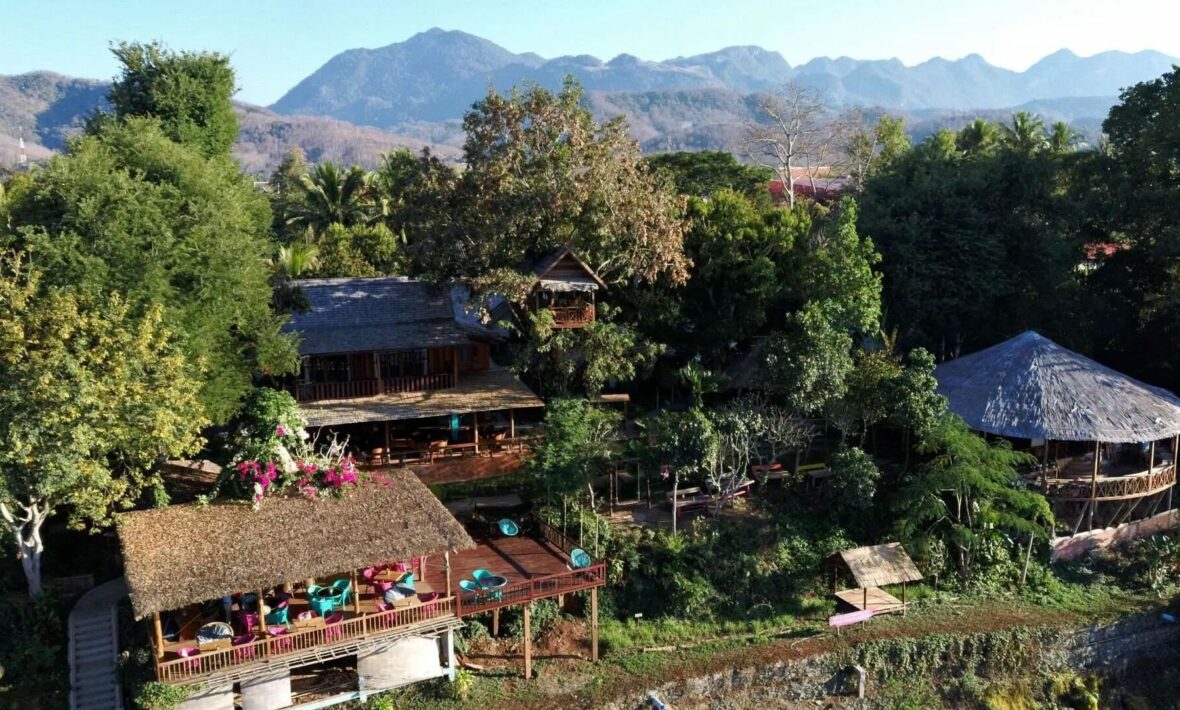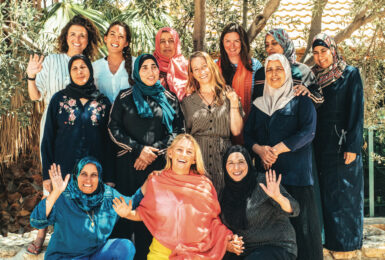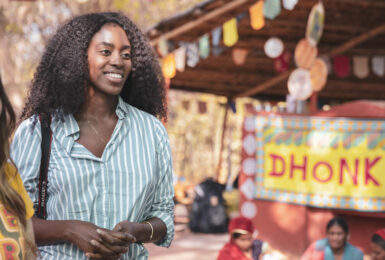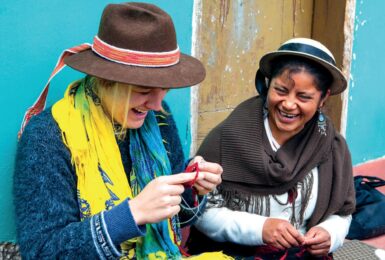Greeted by swathes of intricate patterns and bright, stunning colours, you’ll get to know Laos through its deep history of weaving and textiles. Enter Ock Pop Tock, a female founded, lead, and owned company, empowering women all over the country to harness their skill for crafts and make a living for themselves while sharing their culture.
This MAKE TRAVEL MATTER® Experience takes place on our Laos trips, namely Laos and Cambodia, and you’ll get to watch women weave beautiful patterns and textiles together, and even try your hand at the craft as well. We interviewed Veomanee Douangdala, co-founder of Ock Pop Tock to find out more about this beautiful experience and why she started it all in the first place.
Hi, Veomanee! Could you tell us a little bit about Ock Pop Tock? Where does the name come from?
“I grew up in a weaving family, I helped my mother weave for her own business growing up. And then in 1999 I met the other co-founder of Ock Pop Tock, Jo, and I taught her how to weave, and we started to think about how we could get travellers to be interested in our culture and have them be willing to learn. That’s where the idea of starting our own business came from.”
“This is also where the name comes from: Ock Pop Tock means ‘East meets West’ when translated into English, and that’s our business and design philosophy; it’s a cultural exchange. When Jo was weaving she put the colours down in a different way than traditional textile; it was modern textile. We wanted to bring traditional motifs to modern colour palettes, and locals and travellers together through this experience. Translated, the name also means ‘Sunrise meets Sunset’, a bridging of the two worlds.”
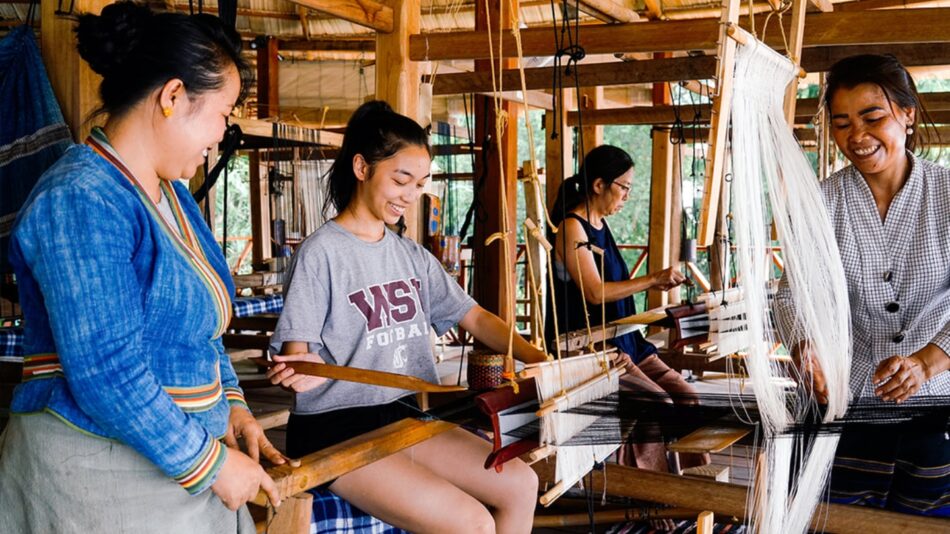
Image source:Contiki
How long have you been weaving?
“Weaving is a very common practice in Laos, and we learn young, from 7 to 12. We help our mothers, our grandmothers, our sisters. As soon as your arms are long enough and your feet can touch the pedals, we weave. We don’t work, it’s just to help out, and it makes us little girls proud to be able to lend a hand at home. My mother taught me when I was 8, I’m the only daughter in the family, so it became an important role for me and it taught me many skills.”
Did you think that Ock Pop Tock would become the business that it is today?
“No, when we started we had no idea it would become such a big operation. We started as a very small group, you know, we went from 5 artisans to 10 to 15, and now almost 50 artisans. The business just kept developing and that was great because we wanted to operate from Fair Trade principles and we want everyone to share in the success that we have.”
“Luang Prabang, where we operate from, became a UNESCO town in 1995, so after that we had a lot of travellers visiting. And the numbers have grown over time so we see a lot of visitors now, so Ock Pop Tock keeps growing as well.”
Can you tell us a little about the tradition of weaving and textiles in Laos?
“The weaving culture in Laos is very strong – we use it for our everyday life, so there’s a daily need for weaving and textiles. You know, it follows you through your life, during every ceremony and important step: birth, weddings, funerals. Woven textiles are used for all of these.”
“Laos is a small country, but there are many, many different groups of people within that have their own cultures. We have 50 main groups, or official groups, but there are around 160 subgroups, and they each have their own cultures and traditions as well, which includes weaving.”

Image source:Ock Pop Tock
How do you think Ock Pop Tock keeps Laos’ traditions alive?
“I grew up weaving because my mother taught me, and she is a trader too, with a business of her own. From this, she gets a good income, which is helpful in carrying on the tradition of weaving. If you can earn money from it, you can keep doing it. You carry on the traditional work at home. Many Lao women grew up weaving as well, this is a skill we have had for a very long part of our lives, so they can earn money too.”
“So, at Ock Pop Tock, we work with our team at the centre, called the Living Craft Centre, and we weave and create an experience for visitors. We tell our story, we share our connections, and we share our culture. They get to know the process of a woven piece from start to finish, and us throughout it.”
How do you support your artisans?
“We have many programs for the artisans to help support them, as well as for the younger generations who want to learn, and everyone gets fair pay and benefits from the business. A lot of our artisans are able to travel around the country so that they can get that life experience and gather more knowledge about the weaving tradition, and also just meet new people.”
“Sometimes, they get to travel abroad as well, and this is really cool. Being a weaver is not a ‘cool’ job in Laos, really, so many of us do it – but when you go outside of the country and tell people you get to share the experience which might not be common in other places, and be really proud of what you do for a living.”
What can Contiki travellers expect when they visit Ock Pop Tock?
“Contiki travellers will visit our Living Crafts Centre, and we offer a free tour of the centre. You get to see all the different stations and, the reason we call it the Living Crafts Centre, is because we have artisans there weaving, so you can see that happening in real time.”
“We also have a shop where you can buy souvenirs and the local weavings that we all make by hand. You can take that home and show all your friends. There is no Ock Pop Tock signature design as such – we get asked a lot – because we work with artisans from all over Laos with different weaving styles and traditions. The prices range from like 1 dollar to 1000 for collectors pieces, as well, so there’s a big range of products.”

Image source:Contiki
What can you tell us about the Village Weavers project?
“The Village Weavers project started because, actually, we found this beautiful textile. It was 4.5m long, and it was from my mother’s hometown, so we wanted to go and meet the artist. It turns out that she is a teacher in her village.”
“There are a lot of women weaving in Laos, but maybe they come from small villages and have no teachers, maybe they have no way of building a profile – so the Village Weavers project is a way for us to help weavers from different villages grow their skills and build a profile, etc. These things can take time, you know, and sometimes people don’t have that time, so we want to help.”
“Currently we work with 14 provinces, so roughly 30 villages and 500 families, but some are seasonal workers, it’s not all full time.”
What kind of impact do you think that Ock Pop Tock has had on the community?
“It has allowed a lot of people to make a good income while still working from home, if they want, and spending time with their children and their community. We also help them grow their skills. You know, many of these women have weaving skills, but also embroidery and other crafts – but we also offer a trainer who can help them improve and learn new crafts.”
“For example, if they want to learn more about textile, traditional textiles, and how to sell them, what colours work well, etc. We bring them to different villages and farms so they can learn different techniques and crafts as well. We want to empower them to learn and grow so that they can make a good living from this.”
“And then these skills get passed on and enrich the community in their own way, so it’s a nice cycle.”
How do you think tours like Contiki and our MAKE TRAVEL MATTER® Experiences help support your organisation and similar ones?
“It’s about awareness, you know? When travellers come to Ock Pop Tock and they get to see what we do right in front of them, and all the work, they understand why the textiles might cost so much. If they didn’t know, maybe they would buy a cheap one from somewhere else, but that cheap one isn’t good quality, it won’t last, it has no history.”
“There is a big problem in this industry of mass-producers copying our designs and making low quality ones, but if travellers get to know our story, they will support us, and all the women that Ock Pop Tock supports. You’re buying something real and authentic, and getting a similar experience from it.”
“This is the reason we created the Living Crafts Centre: we want people to learn how the crafts are made, and all the opportunities that come from this skill. We even run a course like a little workshop where you can try the craft, so you can really see.”
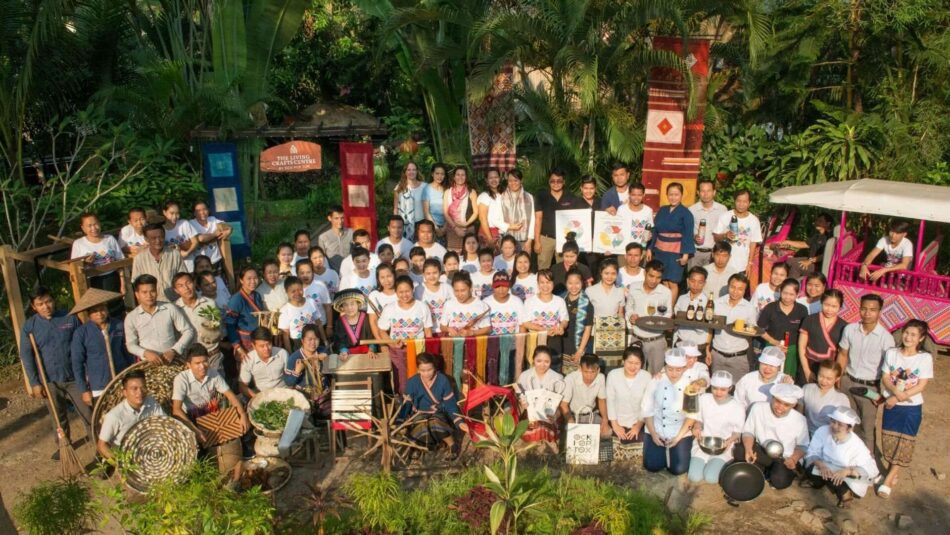
Image source:Ock Pop Tock
Do you have any favourite or meaningful stories from your time at Ock Pop Tock?
“I have many, many stories, but I always share my mother’s story. With her skill and business she was able to make a living for her family and provide. My two older brothers went to university thanks to her and now they can provide for their own families. She is retired now, but her work has had a lasting effect on all of us.”
